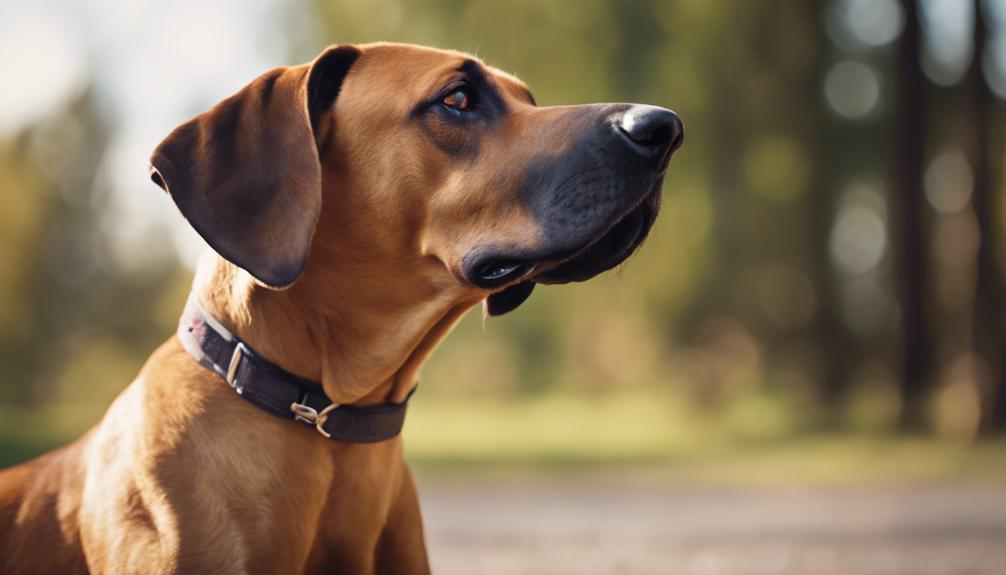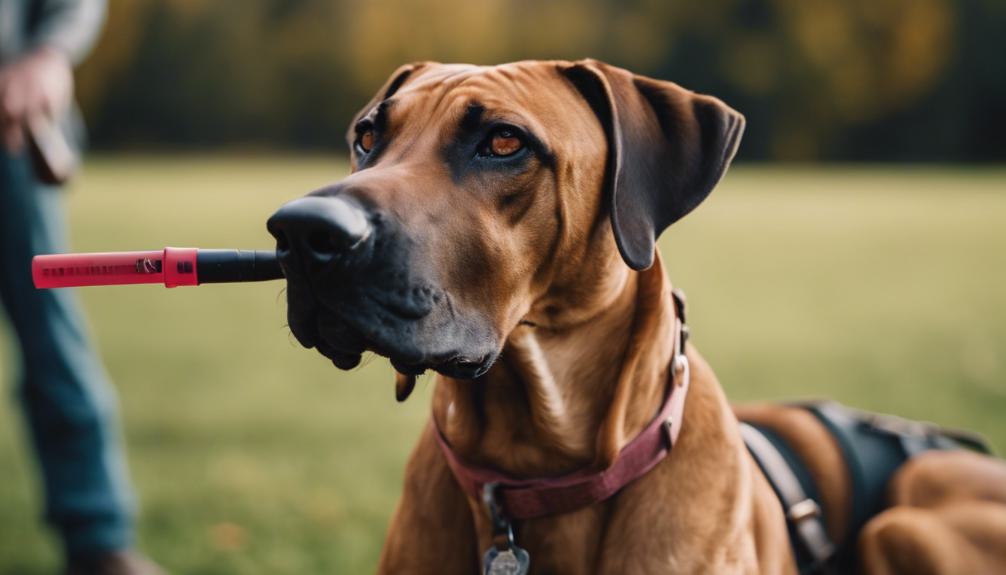How to Train a Ridgeback Dog? Breed-Specific Training Tricks
To train a Ridgeback dog, start with basic commands like ‘sit,’ ‘stay,’ and ‘come.’ Consistency is crucial for effective communication and obedience. Use positive reinforcement such as treats and praise to shape behavior. Socialize your Ridgeback gradually to various stimuli and environments. Crate training is essential, make it a positive experience. Address behavioral challenges patiently. Tailor a balanced diet for their health. Remember, training your Ridgeback requires dedication and positivity to form a strong bond. More insights await on tailoring their diet, health, and addressing challenges for a well-rounded approach to training your Ridgeback dog.
Basic Commands for Ridgeback Training
Begin training your Ridgeback puppy with basic commands like ‘sit,’ ‘stay,’ ‘come,’ ‘heel,’ and ‘leave it.’ These are crucial for effective communication and building a strong relationship. Teaching these commands helps shape your dog’s behavior and boosts obedience. Practice these regularly to ensure your dog’s safety and prepare them for more complex commands later.
Use positive reinforcement methods, such as treats and praise, to motivate your Ridgeback. This approach helps make learning enjoyable and effective.
Start early with these essential commands to set the groundwork for a well-mannered Ridgeback. This strategy leads to a disciplined and responsive pet, enhancing your experiences together.
Importance of Consistency in Training
Train your Ridgeback dog with consistency to reinforce good behavior and clear communication. Keeping your training sessions consistent helps set clear rules and creates a structured environment that enhances obedience and success.
Stick to a regular routine to avoid confusion and provide your dog with a stable learning framework. If you’re inconsistent, you might send mixed signals, slowing down your dog’s learning and understanding.
Regular training also strengthens the bond between you and your Ridgeback by maintaining consistent communication. Use a structured and consistent approach to ensure effective training and meet your obedience goals.
Utilizing Positive Reinforcement Techniques

Implement positive reinforcement effectively to train your Ridgeback dog by focusing on rewarding behaviors you want to encourage. Here are five straightforward strategies:
Reward with treats: Give your Ridgeback tasty treats immediately after they perform a desired behavior during training. This makes them more likely to repeat the behavior.
Offer praise: Verbally commend your Ridgeback and give them affection when they do well. This reinforces their good behavior.
Incorporate toys: Use your dog’s favorite toys as rewards. This makes the training session more enjoyable and engaging.
Ensure consistency: Always reward the behaviors you want to strengthen. This helps your dog understand which actions are beneficial.
Practice patience: Understand that training with positive reinforcement requires time and patience. Remain committed, as this approach helps in developing a strong bond and ensuring obedience from your Ridgeback.
Socialization Tips for Ridgebacks
Introduce your Ridgeback to household items one by one to ease their adjustment to new environments. For example, start with common items like a vacuum cleaner, TV, and washing machine. Organize puppy playdates to build their social skills and allow them to interact with other dogs. This improves their behavior around other pets.
Take your Ridgeback to busy parks for varied experiences. This exposure helps boost their attention span and adaptability. Encourage them to meet different animals, such as cats, birds, and other dogs, to foster good social habits.
Always use positive reinforcement when training your Ridgeback. This approach strengthens your bond and ensures effective socialization. Keep training sessions short and engaging to maintain their interest and progress.
Crate Training for Ridgeback Puppies

Begin crate training your Ridgeback puppy early to build a good relationship with their crate. Here are straightforward tips to ensure success:
- Increase crate time gradually. This helps your puppy adjust without stress.
- Use the crate for housebreaking. This method aids in controlling your puppy’s behavior effectively.
- Ensure the crate is safe and welcoming. Your puppy should see it as a comfortable hideaway.
- Provide consistent, positive experiences. This approach helps your puppy get used to the crate and do well in training.
Each tip is designed to make crate training a positive, straightforward process for both you and your puppy.
Addressing Behavioral Challenges in Ridgebacks
Transitioning from crate training to addressing behavioral challenges in Ridgebacks requires understanding common problems like jumping, excessive barking, and leash pulling. To effectively train your dog, you need to identify what causes these behaviors. Apply training methods and positive reinforcement consistently to steer your dog towards better actions.
For jumping, train your Ridgeback to sit as an alternative. Tackle excessive barking by rewarding them when they’re quiet and using commands such as ‘quiet.’ Manage leash pulling by stopping and changing direction whenever your dog pulls. This encourages them to walk beside you.
View these challenges as chances to improve and succeed in training your Ridgeback.
Tailoring a Balanced Diet for Ridgebacks

Adjust your Ridgeback’s diet based on their age, size, and activity level to ensure they get the right nutrients for optimal health and energy. Here are key points for a balanced diet:
- Craft meals that meet their specific nutritional needs.
- Use treat-dispensing toys to keep their mind engaged and make feeding fun.
- Add food puzzles to challenge their thinking and liven up mealtime.
- Maintain a balanced diet to support overall health and vitality.
- Watch their food intake to keep them at a healthy weight and prevent overfeeding, which helps them live a healthier, longer life.
These steps help your Ridgeback stay active and healthy, without any extra fluff in their diet or your routine.
Ensuring Overall Health and Vitality
To maintain your Ridgeback’s peak health and vitality, prioritize regular veterinary check-ups and vaccinations. A balanced diet specific to their needs is crucial. For mental stimulation, introduce treat-dispensing toys and food puzzles. Ensure they receive adequate exercise to stay vibrant and healthy. Combining diet, mental activities, and exercise promotes overall well-being.
Start training and socializing early. This shapes good behavior across various situations. Include training commands and basic obedience in their daily routine to encourage positive behavior.
This site offers valuable insights into training your Ridgeback effectively.
Frequently Asked Questions
Are Rhodesian Ridgebacks Easy to Train?
Training Rhodesian Ridgebacks can be challenging due to their independent nature and strong prey drive. Consistency, patience, and positive reinforcement are essential for success. Dedicate time and use a gentle yet firm approach for effective communication.
How Do You Discipline a Rhodesian Ridgeback?
To discipline a Rhodesian Ridgeback effectively, provide consistent commands and boundaries. Avoid harsh punishments that can lead to resistance. Redirect unwanted behaviors and reward good conduct. Comprehending their independent nature guides discipline techniques for successful training.
At What Age Do Ridgebacks Calm Down?
Around 2-3 years old, Ridgebacks typically begin to calm down as they mature mentally and physically. Behavioral changes and reduced energy levels are observed as they reach adulthood. Training, socialization, exercise, and consistency help in this process.
Can Ridgebacks Be Aggressive?
Yes, Ridgebacks can be aggressive. Comprehending triggers like fear or territorial instincts is essential. Proper training and socialization are vital. Learn your dog’s body language. Seek help from a professional trainer for managing and correcting aggression.
Conclusion
Training a Ridgeback dog involves several key steps. Start by teaching basic commands like ‘sit’, ‘stay‘, and ‘come’. This sets a foundation for good behavior. Socialize your Ridgeback early by exposing them to different people, pets, and environments. This helps them become well-adjusted adults.
Address any behavioral issues as they arise. Use positive reinforcement, such as treats and praise, to encourage desired behaviors. Avoid harsh corrections, as they can foster fear and aggression.
Ensure your Ridgeback has a balanced diet. Include proteins, vegetables, and grains that cater to their nutritional needs. This supports their health and energy levels.
Always use a calm but assertive tone when training. This shows your Ridgeback that you’re the leader in a way that respects their nature.
With consistent effort and understanding, your Ridgeback will become a well-behaved and loyal family member. Remember, a healthy, well-trained Ridgeback is a happy Ridgeback.

